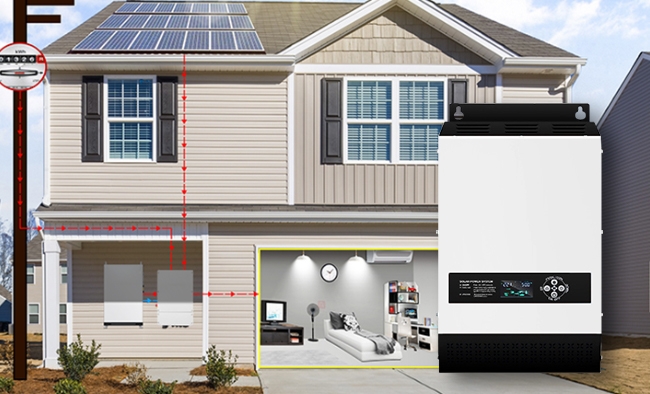-
You have no items in your shopping cart.
- Register
- Log in
- Wishlist
- Shopping cart
Split Phase Off Grid Inverter
1 kW Split Phase Off Grid Inverter Charger, 12V/24V
2 kW Split Phase Off Grid Inverter Charger, 12V/24V/48V
3 kW Split Phase Off Grid Inverter Charger, 24V/48V
4 kW Split Phase Off Grid Inverter Charger, 24V/48V
5 kW Split Phase Off Grid Inverter Charger, 48V
6 kW Split Phase Off Grid Inverter Charger, 48V
A split phase off grid inverter is a type of power inverter designed to convert DC (direct current) electricity from batteries or solar panels into AC (alternating current) electricity for use in residential or commercial settings. It is specifically tailored for split phase systems, which are common in North America and some other regions. These systems provide two 120V lines with a 180-degree phase difference, allowing for both 120V and 240V outputs. This capability makes split-phase inverters ideal for powering a wide range of appliances, from standard household devices to high-power equipment like air conditioners and water pumps.
One of the key features of off grid split phase inverter is its ability to function independently of the utility grid. This makes it an essential component for off grid solar power systems, remote locations, or backup power setups. These inverters often come with advanced features such as battery charging capabilities, hybrid operation modes, and intelligent load management. They can seamlessly switch between power sources, such as solar panels, batteries, and backup generators, to ensure a stable and uninterrupted power supply. Additionally, many modern split-phase inverters incorporate MPPT (Maximum Power Point Tracking) technology to maximize the efficiency of solar energy harvesting. Inverter Online Shop provides different power split phase inverters, such as 1kW split phase off grid inverter charger, 2kW split phase off grid inverter charger, 3kW split phase off grid inverter charger and so on.
The advantages of using a split phase off grid inverter charger include its versatility, energy independence, and the ability to support diverse power needs. However, it also requires careful system design and installation to ensure compatibility with the intended electrical loads and energy sources. Factors like inverter capacity, battery storage, and solar array size must be properly balanced for optimal performance. Overall, this type of off grid solar inverter is a powerful solution for sustainable energy systems, providing both flexibility and reliability for users seeking energy autonomy.
What are the advantages of split phase inverter charger?
Increased Efficiency. Split-phase inverters are highly efficient in distributing power across multiple loads. By balancing the load between the two 120V legs of the split-phase system, these inverters reduce energy waste and improve the overall efficiency of the power system. This results in better energy utilization, which is particularly important for off-grid setups where power is often generated by renewable sources like solar panels or wind turbines.
Cost-Effectiveness. By integrating dual voltage output into a single device, a split-phase inverter eliminates the need to purchase and install separate inverters or transformers to handle different voltage requirements. This not only reduces upfront costs but also simplifies the installation process, saving time and labor expenses. Additionally, the versatility of the inverter means fewer components in the system, which translates to lower maintenance costs over time.
Seamless Integration with Renewable Energy Systems. Split-phase inverters are well-suited for integration into renewable energy systems. They can efficiently convert the DC power generated by solar panels, wind turbines, or battery banks into AC power for use in homes and businesses. Moreover, many modern split-phase inverters come with advanced features like MPPT (Maximum Power Point Tracking) for solar input, ensuring optimal energy conversion and usage.
How does split phase off grid inverter work?
A split phase off grid inverter is designed to convert DC power from a battery bank into AC power suitable for powering appliances in residential or commercial settings. The "split-phase" aspect refers to its ability to provide two separate 120V AC outputs, which are 180 degrees out of phase, enabling the system to deliver both 120V and 240V power. This makes it suitable for North American households where appliances may require either voltage.

The operation begins with the inverter drawing DC power from the battery bank, which stores energy collected from sources like solar panels or wind turbines. Inside the inverter, this DC power is converted to AC power through a process involving high-frequency switching and control circuitry. To produce split-phase AC, the inverter has a center-tapped transformer. The transformer divides the single AC waveform into two outputs that are 180 degrees out of phase. This configuration ensures compatibility with both standard 120V devices and high-power 240V appliances. Advanced split phase inverters also integrate features like maximum power point tracking (MPPT), battery management, and load balancing to optimize performance and energy efficiency.
In an off grid scenario, the inverter acts as the central hub of the power system, ensuring a stable and consistent supply of electricity. It often includes safeguards like overvoltage protection, under-voltage protection, and thermal management to enhance reliability. Many modern split-phase inverters also incorporate monitoring and control capabilities, allowing users to track performance and manage energy usage via a mobile app or control panel. This combination of versatility, safety, and efficiency makes off grid split phase inverters a popular choice for powering independent energy systems.






